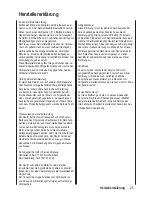
28
28
Safety notices
Installing the receiver
The receiver is to be installed with a foam rubber cushion
to afford protection against jarring, in aircraft models
behind a strong rib and in a car or ship model in a place
where it is protected against dust and spray water.
The receiver may not be mounted in direct contact with
the hull or chassis as this would allow motor vibrations
and/or landing jolts to be transferred directly to the
receiver. When a receiver system is installed in a model
with a combustion motor, all receiver parts should be
installed so as to prevent exhaust gases and oil residues
from infiltrating. This especially applies to the ON/OFF
switch, which is usually built into the model’s outside skin.
Position the receiver such that connecting cables to the
servos and the power supply are routed with a bit of slack
and that the receiver’s antenna is at least 5 cm away
from any large metal parts or wiring other than those
proceeding from the receiver. In addition to steel, this also
applies to carbon fiber parts, servos, electric motors, fuel
pumps, any kind of cable and similar items.
Optimally the receiver should be placed at a readily
accessible location that is well away from all other
equipment. Under no circumstances may a servo cable
be wrapped around the antenna or routed close to it.
Ensure that cables near the antenna cannot move about
during flight.
Routing the receiver’s antenna
The receiver and the antennas must be positioned as
far away as possible from any drive components. If the
model’s hull is made of carbon fiber material, the ends of
the antennas should always extend outside of the hull.
The orientation of antennas is not critical. Nevertheless,
a vertical (upright) installation of the receiver’s antenna(s)
is advantageous. In the case of diversity antennas (two
antennas), the second antenna should be mounted at a
90° angle to the first antenna.
Servo installation
Always mount servos with the rubber vibration-damper
parts provided. This is the only way of ensuring some
protection against excessively strong vibrations.
Installing linkage
Linkage must be installed so as to ensure unhindered
and smooth movement. It is particularly important that all
rudder levers are able to move to their full limits and are
not blocked mechanically.
In order to be able to stop a running motor at any time,
the linkage must be set to ensure that the carburetor tap
is completely closed when the joystick and trim lever are
brought into their end idle positions.
Pay attention that no metal parts rub against one another,
e.g. as a result of moving the rudder, of vibration, rotating
parts etc. Metal-to-metal contact causes ‘static’ which can
interfere with the correct operation of the receiver.
Transmitter antenna orientation
The patch antenna is integrated in the rectangular
front panel of the transmitter. This means that ‘aiming’
the transmitter at the model will have a positive effect
on reception. However, when two or more pilots using
2.4 GHz remote control systems are within 5 m of one
another this can lead to return channel overdrive which,
in turn, will trigger a range warning much too soon.
Increase your distance between one another until the
range warning ceases.
Pre-start checks
Before switching the receiver on, ensure that the throttle
control is in the Stop/Idle position.
Always switch the transmitter on first and then the
receiver.
Always switch the receiver off first and then the
transmitter.
Warning:
If this sequence is not maintained, and the
receiver is still switched on when the corre-
sponding transmitter is switched to the ‘OFF’
position, then the receiver may respond to other transmit-
ters or general radio frequency noise. This can cause the
model to execute uncontrolled operations that may cause
personal injuries and/or property damage.
The following applies in particular to models equipped
with a mechanical gyro:
Before switching off the receiver, disconnect the model’s
power supply to prevent the motor from revving up
unintentionally.
The residual spin of a gyro often produces a level of
voltage that the receiver can falsely interpret as valid
throttle signals. This can then cause the motor to start up
unintentionally.
Range test
Perform checks for proper operation and range before
any use. Secure the model adequately in place and
ensure that no one is in front of the model.
Perform a complete functional test on the ground and
















































